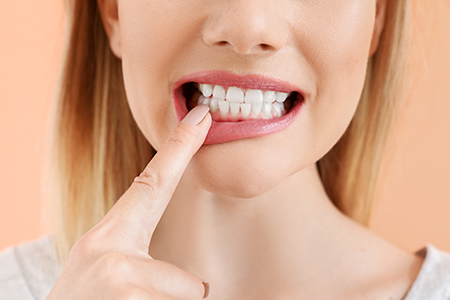We speak English, Spanish and Portuguese
We speak English, Spanish and Portuguese

Gum disease is the most common cause of adult tooth loss, and its early stages can be easy to miss. Studies from national public health organizations indicate that roughly half of adults over 30 show signs of periodontal disease. While that sounds alarming, periodontal conditions are largely preventable and highly treatable when detected early. At Inspirational Smiles, we focus on clear explanations, careful diagnosis, and individualized care so patients can keep their gums healthy and their smiles functioning for years to come.
Periodontal disease refers to infection and inflammation of the tissues that surround and support the teeth — the gums, ligaments, and jawbone. It begins when bacterial plaque accumulates along and below the gumline. Over time, this bacterial buildup triggers an inflammatory response that, if unchecked, damages the soft tissue and bone that anchor teeth in place.
Because early gum disease often causes little pain, many people do not realize something is wrong until the condition becomes more advanced. That’s why routine dental examinations and cleanings are essential: they let clinicians identify early warning signs before irreversible damage occurs.
Left untreated, periodontal disease can undermine chewing comfort, alter the position of teeth, and contribute to tooth mobility and loss. It also creates pockets around teeth where bacteria can thrive, making long-term control more challenging. Understanding how the disease begins is the first step toward preventing its progression.
You don’t need to be an expert to spot many of the early indicators of gum inflammation. Some signs are visible or can be felt at home during your daily oral care routine. Noticing and acting on these signals can prevent more extensive treatment down the road.
Common signs to watch for include:
Red, swollen, or tender gums
Gums that bleed during brushing or flossing
Receding gumlines and exposed root surfaces
Increased tooth sensitivity to hot and cold
Persistent bad breath or an unpleasant taste in the mouth
Loose teeth or a noticeable change in how teeth fit together
Discharge near the gumline or pain when biting

Oral health is closely connected to overall health. Research continues to show associations between untreated periodontal disease and systemic conditions such as cardiovascular disease, diabetes, and respiratory illness. While gum disease does not cause these conditions directly in every case, chronic oral inflammation can complicate other health issues and affect general wellness.
That connection makes prevention and early treatment more important than ever. Maintaining healthy gums reduces the bacterial load in the mouth, lowers inflammation, and helps create a healthier environment for the entire body.
At our practice, we emphasize patient education and routine care because controlling periodontal risk factors — including smoking, uncontrolled blood sugar, and poor oral hygiene — is essential to long-term success.
Gingivitis is the earliest, reversible stage of gum disease. It is characterized by inflammation confined to the gum tissue without loss of bone or connective tissue. Common symptoms include redness, swelling, and bleeding during brushing or flossing.
When gingivitis is addressed promptly with improved oral hygiene and professional cleanings, the gum tissue can recover fully. Treatment at this stage typically focuses on removing plaque and calculus, coaching on brushing and flossing techniques, and establishing a regular maintenance schedule.
Success here depends on a partnership between patient and provider: regular monitoring, consistent at-home care, and timely professional cleanings are key to returning to and maintaining periodontal health.

If inflammation persists, gingivitis can progress to periodontitis, a stage marked by destruction of the supporting structures around the teeth. Attachment loss, deeper periodontal pockets, and jawbone changes may occur, and these changes are not always reversible.
Managing periodontitis focuses on halting disease activity, reducing pocket depths, and preserving remaining bone and tissue whenever possible. Treatment becomes more involved and may include targeted cleaning below the gumline, antimicrobial therapies, and sometimes surgical procedures to reshape tissues and encourage healing.
Even in advanced cases, modern periodontal therapies aim to stabilize the condition and restore function. With consistent follow-up care and a tailored home care plan, many patients maintain healthy, comfortable mouths for years after treatment.
Treatment for periodontal disease is never one-size-fits-all. Your dental team will evaluate the extent of inflammation, measure pocket depths, review medical history, and consider risk factors to recommend an individualized plan. Communication is central: we’ll explain the rationale for each step so you understand what to expect and why it matters.
Non‑surgical therapies are typically the first line of treatment. These approaches aim to remove irritants under the gumline and allow the tissue to reattach to the tooth surface. If pockets remain deep or disease has caused significant tissue loss, surgical or regenerative procedures may be recommended to address those specific issues.
Following active treatment, a personalized maintenance schedule helps prevent recurrence. Periodontal health is a long-term effort that combines professional care with daily habits — and that ongoing commitment is the best way to protect your smile.
Early and moderate periodontal disease is frequently managed with non‑surgical techniques designed to reduce the bacterial burden and encourage healing. Scaling and root planing — a deep cleaning performed below the gumline — removes plaque and calculus from root surfaces and helps the gum reattach more closely to the tooth.
Clinicians may use local antimicrobials applied beneath the gums or recommend adjunctive systemic medications when appropriate to help control bacterial populations. These conservative methods prioritize tissue preservation and are often effective when combined with improved at-home oral hygiene and regular monitoring.
If non‑surgical therapy does not achieve the desired results, the care team will discuss additional options, focusing on strategies that best preserve function and comfort.
When pockets are too deep for non‑surgical cleaning or when there is significant tissue and bone loss, surgical approaches may be necessary. Pocket reduction (flap) surgery allows direct access to the roots and supporting bone so clinicians can thoroughly clean the area and, when needed, reshape the bone and soft tissues.
Regenerative procedures — including bone grafts and tissue-guiding techniques — are used to rebuild lost structures in select cases. These treatments aim to restore support to the teeth and improve long‑term stability, and in many situations they also create a better foundation for future restorative work.
Newer technologies such as lasers can be incorporated into periodontal care in specific cases to help reduce pocket depth, address peri-implant inflammation, or refine gum contours for improved hygiene and appearance.

Keeping gums healthy is an ongoing process that blends preventive care, timely treatment, and consistent home hygiene. If you have noticed any signs of gum disease or if it has been a while since your last periodontal evaluation, contact us to learn more about how we can help preserve your oral health. Our team is available to answer questions and guide you through the options that best fit your needs.

Most people don’t realize that periodontal disease is the leading cause of tooth loss among adults. According to statistics from the Centers for Disease Control and Prevention, one out of every two adults over the age of 30 in the United States has periodontal disease.
You may be surprised to learn that the human mouth is home to a wide variety of microbes. The fact is that over 700 different strains of bacteria have been detected in the oral cavity. Although some of these bacteria are beneficial, others are harmful to oral health. Without proper oral hygiene and routine dental care, these harmful bacteria can cause tooth decay and gum disease, compromising both your oral health and overall wellbeing.
In addition to inadequate oral hygiene and infrequent professional care, other factors, including smoking, genetic tendencies, and unchecked diabetes, can contribute to the escalation of periodontal disease.
Your gums and teeth have an interdependent relationship, which means healthy teeth depend on the support of healthy gums. Also, taking care of your smile does more than keep your teeth and gums in optimal condition; good oral health also supports systemic health. In addition to being the leading cause of tooth loss in adults, researchers are finding more and more links between periodontal disease and a number of medical problems, including heart disease, stroke, diabetes, respiratory problems, and adverse pregnancy outcomes such as pre-term and low birth-weight babies.
If you notice that your gums are bleeding with the slightest pressure while brushing or flossing, it’s a sign of gingivitis. Although gingivitis is the earliest stage of gum disease, it can easily be reversed with deeper cleanings as well as an improved regimen of oral hygiene at home.
In the absence of professional treatment and better home care, gingivitis progresses to the next stage, which is known as periodontitis. In this stage, the connective tissue and bone that hold the teeth in place begin to break down with an increase in pocketing between the teeth and bone, gum recession, and bone loss. Without proper treatment by your dentist, periodontitis will progress from a mild to moderate loss of supporting tissue to the destruction of the bone around the teeth.
Although gingivitis can often be reversed with improved oral hygiene and professional cleanings, as periodontal disease advances, more extensive procedures are required to halt its progression. Based on a complete assessment of your periodontal health and a review of possible contributing factors, our office will recommend the best options in care. Treatment for periodontitis may include a series of deeper cleanings known as root planing and scaling, surgical procedures to reduce pocket depth, bone or tissue grafts, laser procedures, or antimicrobial medications.
The cost of care depends on the type of procedures required to restore your periodontal health. If you have dental insurance, plans often cover treatment to prevent gum disease as well as many procedures to treat the various stages of gum disease. Our goal is to help patients restore and maintain good oral health. We do all we can to help you begin care without additional stress or delay. Our business office works with you to maximize your benefits and provide easier, more convenient payment options.
By seeing our office regularly for care and doing your best to eat a healthy diet and practice good oral hygiene, you can keep your smile in tip-top shape as well as protect your overall wellbeing.
At the office of Inspirational Smiles, we provide a comprehensive range of services to address all your oral healthcare needs. You can rest assured that your smile is in the best of hands at our office. Our skilled and experienced team maintains a position at the forefront of advances in care and remains dedicated to providing the highest quality of skilled and compassionate treatment.

Looking to schedule your next dental visit or learn more about our services?
Getting in touch with Inspirational Smiles is simple! Our caring team is ready to help with appointment scheduling, questions about treatments, or any concerns you may have. You can call us or use our easy online contact form—whatever works best for you.
Take the first step toward a healthier, more confident smile today and experience the difference that personalized, compassionate dental care can make.